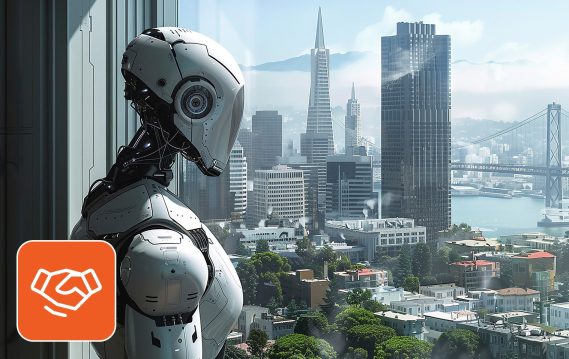Artificial Intelligence has stopped being a futuristic talking point. It has become a structural force reshaping the U.S. job market, quietly at first, then all at once. What began as the automation of routine tasks has quickly expanded into decision-making, strategy, and growth itself.
From recruitment pipelines to financial modeling and patient diagnostics, AI in US hiring is the engine accelerating how organizations operate and scale.
According to McKinsey’s state of AI report 2025, 78% of organizations now use AI in at least one business function, up from 72% earlier in 2024 and 55% the year before.
As this technology takes hold, the effects are not limited to individual roles. Entire industries are reconfiguring. Healthcare and fintech are reinventing service delivery with predictive analytics.
Logistics firms rely on AI’s forecasting power as much as they once relied on fleet managers. Hiring is no exception, because the very skills needed to run these systems have shifted sharply, and the people who possess those skills are clustering in new places.
The story, then, is no longer just about what kinds of jobs exist. It’s about where they are proliferating and which cities are becoming magnets for tomorrow’s workforce. Traditional talent hubs remain relevant, but secondary markets are emerging as AI adoption in recruitment accelerates across geographies. For employers, that means the old recruitment maps are starting to fail.
AI’s Impact on US Talent Hubs
When we talk about “talent hubs,” we usually think of familiar names like San Francisco or New York, all cities that historically attracted concentrated pools of skilled professionals. But AI in US hiring has disrupted that equation. Instead of clustering only on the coasts, opportunities are fragmenting across secondary cities and hybrid hubs.
Take Austin. Once known primarily for its startup culture, it’s now one of the fastest-growing AI-driven ecosystems in the country. Companies are blending AI into everything from fintech to supply chain analytics, creating steady demand for data scientists, project managers, and AI-aware recruiters who can interpret and act on machine-driven insights.
Or look at Raleigh. Long anchored by its universities and research triangle, Raleigh is emerging as an AI-fueled hub for healthcare IT and biotech analytics. This is a key point in demonstrating how AI in recruitment triggers adjacent job growth in healthcare, compliance, and patient engagement roles.
Meanwhile, Dallas and Atlanta are proving how logistics, financial services, and telecommunications industries are fueling AI integration. As predictive modeling and automation take hold, demand is rising for professionals who can bridge technical AI tools with operational management.
In short, AI in hiring is pulling gravity away from legacy hubs and giving rise to regional ecosystems. For employers, this means tapping into new geographies where talent may be more available, less saturated, and deeply motivated to work in AI-driven roles.
Key AI Workforce Trends in the US
The U.S. job market AI wave is reshaping the mix of skills and industry demands. What you’ll notice is not a simple “jobs disappearing” narrative, but a far more layered reality.
1. Augmentation vs Automation
While some repetitive roles are being automated, most of the U.S. workforce disruption is about augmentation.
AI in recruitment doesn’t eliminate the need for analysts or recruiters; it requires them to become better interpreters of data, decision drivers, and strategists.
Consider recruiting: AI can screen thousands of resumes in a single click, but human judgment is still essential for assessing cultural fit, nuanced skills, and long-term success potential.
2. New Skills in Demand
We’re now in an era of hiring where AI literacy is as fundamental as Excel once was. Business analysts who can query AI tools, HR teams that can check for algorithmic bias, or nurses familiar with clinical decision-support systems; these hybrid skill sets are defining the future of work in AI.
3. Cross-Industry Shifts
AI workforce trends are not confined to technology alone. Healthcare is leveraging AI for patient diagnostics, fintech is using AI for fraud detection, and logistics relies on AI in demand forecasting.
These cross-industry applications mean that AI talent isn’t just clustering in Silicon Valley but spreading into hubs tied to industry specialization.
Together, these shifts are redefining the Hiring Landscape and making flexibility in workforce planning more essential than ever.
What This Means for Hiring Strategies
The traditional hiring playbook of posting a role and waiting for inbound applications, cannot keep pace with how AI in US hiring is redistributing demand and skill sets.
- Talent shortages in AI-driven hubs: Austin and Raleigh may be booming, but competition for AI-capable professionals in these markets is already intense. Recruiters must go beyond job boards and build relationships early in the talent pipeline.
- Flexible staffing as a necessity: Business cycles move faster when AI is involved. Project-based needs (like implementing an AI analytics tool) and long-term strategic hires coexist, requiring employers to embrace models like staff augmentation, contract-to-hire, and contingent staffing.
- Workforce planning tied to shifting hubs: Companies that rely only on traditional metros miss out. A smart hiring strategy with AI involves evaluating where secondary and tertiary hubs (think Charlotte, Phoenix, or Denver) are becoming reservoirs of specialized skills. Employers who align expansion with these hubs stand to gain an early advantage in retention and cost competitiveness.
How Companies Can Adapt
AI adoption doesn’t mean building teams blindly around technology. The leaders who succeed will balance AI capability-building with long-term workforce sustainability. Here’s how:
1. Build AI-Ready Hiring Frameworks
This means developing structured approaches to evaluate candidates not only for current jobs but also for their capacity to learn and adapt alongside AI tools. For example, when hiring recruiters, evaluate candidates on their ability to use AI-enabled sourcing platforms rather than just traditional resume scanning.
2. Upskill and Reskill Existing Teams
Relying solely on external hires for AI roles is a losing strategy because it’s expensive and competitive. Internal upskilling, whether through micro-credentialing or partnerships with local universities in talent hubs, is critical to bridging gaps faster than the open market can supply.
3. Partner Strategically
The reality is that most companies are not moving fast enough on their own. Staffing firms with deep understanding of AI in recruitment and AI workforce trends in the US, such as SPECTRAFORCE, give businesses a competitive edge. They bring access to diverse candidate pools in hubs and also proven playbooks for scaling projects or building specialized teams.
Conclusion: Beyond Geography, Toward Strategy
If AI is changing jobs, it’s also, more profoundly, changing the map of opportunity. It’s no longer enough for HR leaders to ask: What roles do I need to fill? The sharper question is: In which hubs will those roles emerge, and how do I position my strategy there before the wave crests?
Contrary to popular perception, AI is not erasing human work; it is merely redistributing it. It is localizing it differently and layering it with new requirements. Talent ecosystems are no longer bound to legacy geographies, and the existence of secondary hubs makes it evident. Every organization that treats hiring as a static process risks missing the acceleration that AI brings.
The takeaway is straightforward but urgent: the hiring landscape is fragmenting, and strategy must fragment with it. Flexible staffing models, AI-literate workforce planning, and intentional upskilling are survival tools for competing in tomorrow’s market.
For organizations ready to align themselves with this reality, the path forward is to partner with staffing leaders who understand context alongside tech. That’s the edge that keeps companies ahead of the curve.
Ready to recalibrate hiring to the new AI reality? Partner with SPECTRAFORCE to align workforce planning, flexible staffing, and AI‑driven recruiting where the talent truly is.
Speak with an expert to map needs by hub, build AI‑literate pipelines, and stand up project teams fast.
FAQs
The US cities emerging as key talent hubs due to AI include Austin, Raleigh, Dallas, and Atlanta. Unlike traditional centers such as San Francisco, these cities are gaining prominence because of their industry specialization, strong university pipelines, and relatively lower market saturation, making them attractive for both employers and professionals.
The skills most in demand in AI-driven US talent hubs include AI literacy, advanced data analytics, algorithmic bias detection, and the integration of machine learning into non-tech roles. Additionally, domain-specific applications are driving local demand, for instance, healthcare AI expertise in Raleigh and fintech-focused AI skills in Dallas.
Companies can adapt their hiring strategies to AI-driven workforce trends in the US by embracing flexible staffing models, prioritizing reskilling and upskilling initiatives, and working with staffing partners who understand both AI in hiring and the geographic shifts of talent hubs. These adjustments help organizations stay competitive in markets where demand is rising faster than supply.
AI is transforming the US job market and talent hubs by redistributing demand from legacy centers, such as the Bay Area, to emerging cities like Raleigh, Austin, Dallas, and Atlanta. This shift is creating hybrid skill requirements, accelerating job growth in non-traditional hubs, and pushing companies to adopt more dynamic, AI-ready hiring strategies.



